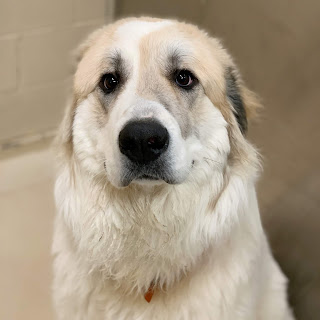Get to know your dog’s calming signals
Trainer Turid Rugaas of Norway spent years
observing wolves, wild dogs and domestic canines to better understand how they
communicate. Calming signals are a means of communication used by dogs to not
only calm themselves, but also each other and even us. Knowing calming signals
allows us to better understand how our dogs are communicating. Once we know and understand the calming
signals, we will know when to remove our dogs from situations they are
uncomfortable with because we’ll see the warning signs ahead of time.
Blinking - This is done
to avoid staring/direct eye contact. It
can be full, slow blinking or just the lowering of eye lids.
Curving - It’s proper
‘doggy manners’ for dogs to approach each other by curving to greet. They do not greet each other by approaching straight
on unless they know the other dog.
Approaching another dog straight on may cause conflict between the
dogs. If your dog tries to curve when
meeting another dog, let them do it - they are providing a clear message and
proper dog communication. You can help
your dog on walks by allowing them to curve away while on leash so that they do
not send the wrong message or indicate a challenge to the other dog.
Licking - You may see
your dog licking his mouth/nose when he is in a tight situation such as when
another dog or person is walking straight towards him or when you are bending
over your dog. This is most common in
dogs with dark faces as it is harder to see their facial expressions.
Looking Away - This can be
from the whole head or by just casting the eyes away. It is considered the most common calming
signal that dogs will use. They will
look away from anything that needs calming as staring directly at another dog
can be considered threatening or a challenge.
Play Bow - A play
position is when a dog has his front legs down and his bum in the air. It is used to initiate play as well as a
calming signal. If a dog is uncertain
with how to deal with a situation, he will often exhibit the play
position. This is seen most commonly
when a dog encounters a strange animal such as a cow.
Sitting/Lying Down - Dogs may do
this to reassure one another that they mean no harm.
Sniffing - Dogs will
commonly sniff the ground to calm a situation or another dog down.
Turning Away - A dog who is
feeling a bit nervous about an object, person or another animal will turn away
from it. This can be rather slight with
just turning the head, or they may completely turn away. You will often see dogs do this to each other
if one is playing inappropriately.
Walking Slowly - Dogs will move
slower to calm another dog or person down, or will do this if another dog is
feeling uncertain about a situation.
This is a common one to see in dog play and greetings.
Yawning - Your dog may
yawn when he’s tired but it is also used to release stress and calm
others. When the dog is using a calming
signal when yawning, the yawn tends to be exaggerated.
If you would like to further understand
your dogs’ behaviour or work on training, Cochrane & Area Humane Society
offers a variety of seminars, training and behaviour consultations for you and
your dog. Please visit http://www.cochranehumane.ca/programs/animal-training/
for more information.



Comments
Post a Comment